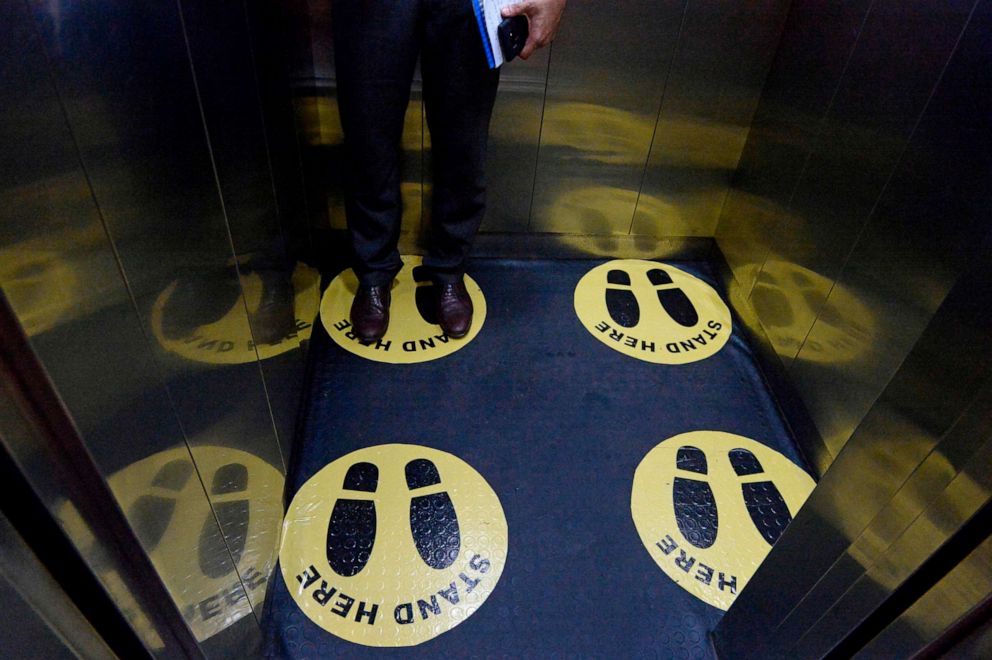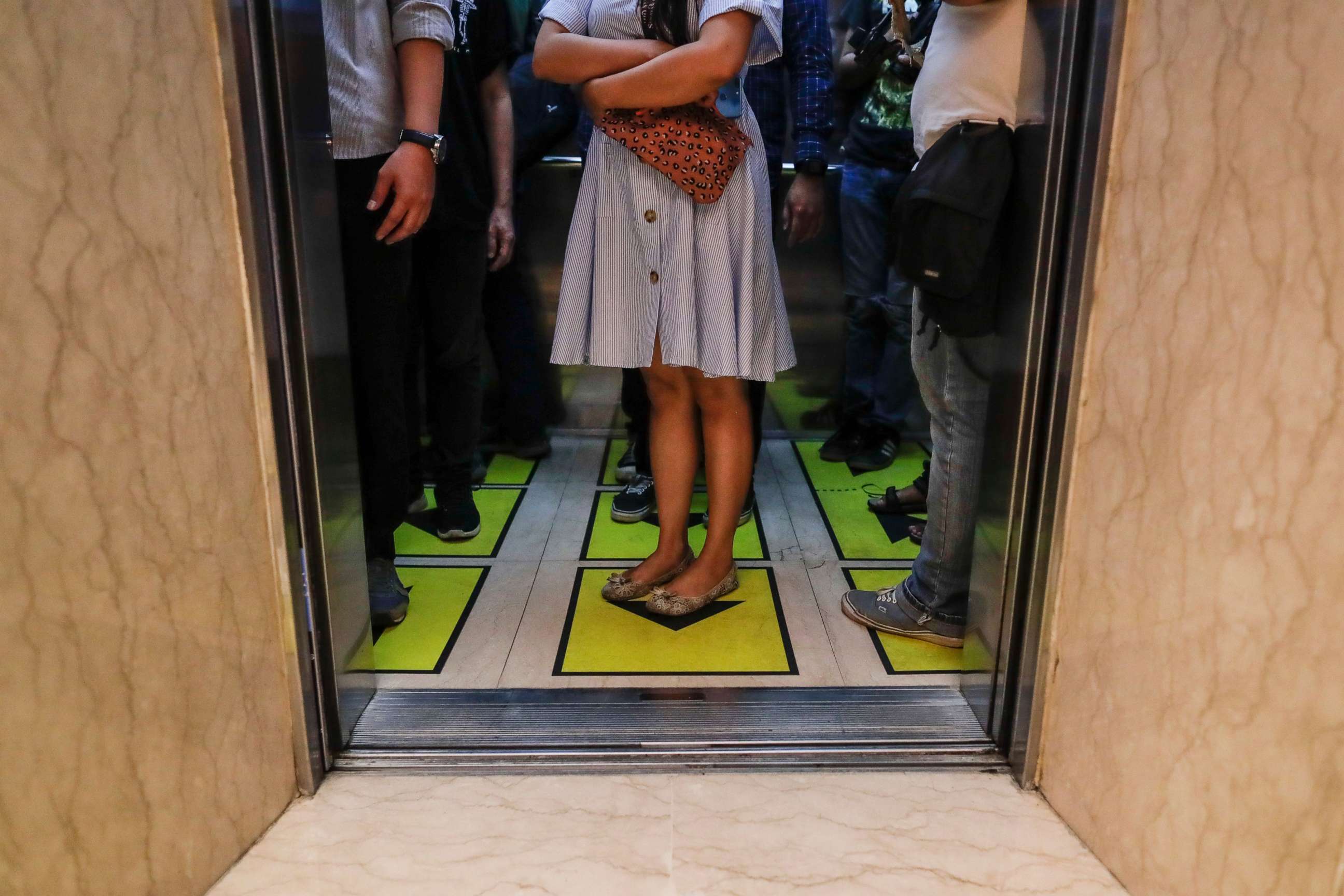Going up: How do you stay safe from COVID-19 in an elevator?
Studies suggest elevators aren't the most dangerous place in a crowded building.
As offices start to reopen and people across the world return to working in busy office buildings, an important question is being asked: should I be taking that elevator?
For many people working in high-rise buildings, the elevator is a necessity, but the good news is that riding the elevator does not seem to be a major way the novel coronavirus is transmitted.
However, since you are enclosed in a small box with other people, there are concrete steps you can take to stay safe: wear a mask, stand away from others and touch as little as possible.
There are two ways COVID-19 may spread in an elevator: from fellow riders, or from particles expelled by a previous rider with coronavirus that has remained inside the elevator.
Elevator rides tend to be short, which is fortunate when it comes to a virus that is more contagious over long periods of in-person contact.
Experts say the risk of transmission directly from fellow elevator riders is small as long as you follow basic safety advice.
Studies into the spread of the virus suggest that elevators are not the most dangerous place in a crowded building.
In March, during a COVID-19 outbreak in a busy 19-story building in Seoul, the virus spread almost exclusively between individuals working on the same floor. The authors of the case report that even with considerable interaction between workers on one floor with those on other floors, the virus did not appear to spread vertically through the building.
"This argues that elevators are not a hot spot for transmission" said Dr Todd Ellerin, director of infectious diseases at South Shore Health in Weymouth, Massachusetts.
Despite the low risk, experts say you should still take the necessary steps to protect yourself from exposure.
"Risks for coronavirus from riding on the elevator are low. However, continue to take precautions while riding on the elevator. Always wear a mask/facial covering," agreed Dr. Simone Wildes, infectious disease specialist at South Shore Health.
"Time is our biggest risk reducer," Ellerin said. "The short time people spend on elevators together will mitigate against large amounts of transmission".

Anecdotally, Ellerin said that his hospital system has multiple elevators and more than 6,000 staff members, but has had fewer than 150 staff members infected with COVID-19 symptoms.
"It is unclear how many of the staff used the elevators during this time, but if elevators were a hot zone for transmission, we might have expected to see more staff infections," he said.
Nonetheless, being in a small, crowded and enclosed space is still concerning -- so it is important to follow safety advice.
Dr. Carlos del Rio, professor of global health and epidemiology at the Rollins School of Emory University, emphasized the critical importance of wearing masks.
Regarding the Seoul outbreak, he said that because the case study took place in South Korea, where mask wearing is more prevalent, "everyone was most likely sure to be wearing a mask."
A recent study showed that if half or more of the population wore face masks, transmissions might drop dramatically.
"As long as people refuse to wear masks, we will not be getting away from this virus" said del Rio.
"The data on face coverings is very reassuring," said Dr. Ellen Eaton, assistant professor of infectious diseases at the University of Alabama at Birmingham.
"It is likely that mask use can prevent overwhelming subsequent waves of COVID," Eaton said. "The catch is that Americans have not embraced face coverings."
Other things you can do to reduce risk: avoid crowded elevators, stand in opposite corners of the elevator from your co-riders, and take the stairwell as an alternative if you can.
Stairwells tend to be less crowded and as an added bonus are a great way of getting some exercise. Lastly, be wary of elevator etiquette. Sneezing, coughing or speaking loudly will release more virus into the elevator and increase chances of it spreading. Many buildings have implemented a 2-4 person restriction to enable distancing.
Although less likely, there is a small risk that you could catch COVID-19 on elevators from previously expelled viral particles collecting on surfaces. We can reduce these risks through hand sanitization, avoiding touching our faces, and using an elbow or tissue to press buttons.

The coronavirus can remain for minutes-to-hours in the air, and for days on commonly used elevator surfaces. Indeed, large amounts of the coronavirus were detected on most touchable surfaces in a hospital designated for COVID-19 patients in Wuhan, including elevator buttons.
However, experts stress that it is still unclear if the viral particles that have been detected as part of these studies are actually infectious.
"This is the big debate right now" says Dr. Eric Cioe-Pena, director of global health at Northwell Health in New York City.
However, experts emphasize that the most likely way you will be infected with coronavirus is not via surfaces, but through person-to-person interactions. Therefore wearing a mask and social distancing are most important.
The CDC also recommends regular disinfection of elevator buttons with EPA-registered disinfectant. Alternative UV sterilization systems are also available. In addition, you can install antiviral films to cover elevator buttons which contain copper to hasten the breakdown of viral particles. Some malls have even installed foot pedals to prevent button-to-hand mediated spread.
So, are elevators safe? All we can say for now is -- it depends. Are you alone or is it crowded? Are you wearing a mask? Is someone speaking loudly on the phone inside?
"So many of these scenarios are not studied," said Dr. John Brownstein, epidemiologist at Boston Children's hospital and an ABC News contributor.
"Transmission is theoretically possible, but we just don't know," Brownstein said.
With this uncertainty, the best we can do is reduce the risks. The advice is clear: stand away from others, don't speak, avoid touching surfaces, hand sanitize, and most importantly, wear a face covering. If you follow these rules, your trip on the elevator should be a safe one.
What to know about the coronavirus:
- How it started and how to protect yourself: Coronavirus explained
- What to do if you have symptoms: Coronavirus symptoms
- Tracking the spread in the U.S. and worldwide: Coronavirus map
Tune into ABC at 1 p.m. ET and ABC News Live at 4 p.m. ET every weekday for special coverage of the novel coronavirus with the full ABC News team, including the latest news, context and analysis.
Hassal Lee, an M.D. Ph.D. student who completed her Ph.D. in neuroscience and is entering her final year of medical school at the University of Cambridge, U.K., is working with the ABC News Medical Unit.




